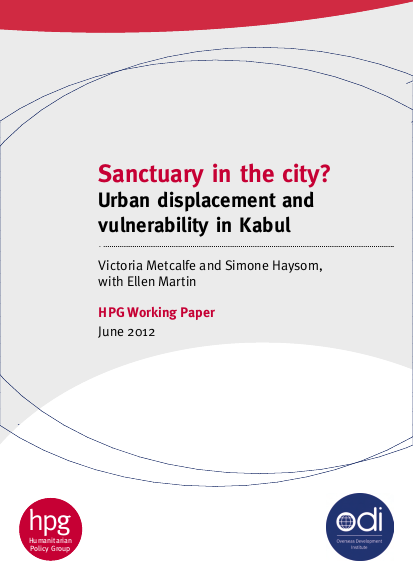
In recent decades, many cities and towns around the world have seen dramatic population growth, with significant inflows from rural areas. A prominent feature of this global trend of urbanisation is forced displacement triggered by armed conflict, violence and political instability or slow- and sudden-onset disasters – or a combination of these factors. Many of those forcibly displaced have moved to urban areas in search of greater security, including a degree of anonymity, better access to basic services and greater economic opportunities. Today, approximately half of the world’s estimated 10.5 million refugees and at least 13 million internally displaced people (IDPs) are thought to be living in urban areas (UNHCR, 2009b; IDMC, 2010).
While a number of studies in recent years have sought to analyse urban livelihoods and urban governance, there remains little understanding of how the displaced negotiate their way in the urban environment, their relationships with the host community and governance institutions and their specific vulnerabilities compared with other urban poor. In addition, the role of humanitarian and development actors in supporting these populations, and the strategies and approaches best suited to addressing the assistance and protection needs of urban IDPs, are still poorly under-stood.
The Humanitarian Policy Group (HPG) at the Overseas Development Institute (ODI), in cooperation with the Internal Displacement Monitoring Centre (IDMC) and the International Committee of the Red Cross (ICRC), is carrying out a series of studies on urban displacement. This multi-year research project, supported by the Ministry of Foreign Affairs of Denmark, explores the phenomenon of displacement in the urban environment and the implications and challenges that it poses for humanitarian action. Through field research in eight urban centres in Africa, the Middle East and Central Asia, the research aims to consider the reality of life for displaced populations in urban areas, investigate the policy and operational challenges that confront national and international stakeholders when responding to the needs of urban IDPs and refugees, and offers recommendations for strengthening support to these populations.
This study is part of a larger body of work undertaken by HPG on urbanisation, including a DFID-funded research study in Sudan (‘City Limits: Urbanisation and Vulnerability in Sudan’, published in January 2011) and a study of urban refugees in Nairobi conducted jointly by HPG and the International Rescue Committee (IRC), in partnership with the Refugee Consortium Kenya (RCK) (Pavanello et al., 2010).
Resource collections
- Coordination
- UN Habitat - Urban Response Collection
- Urban Response - Urban Crisis Preparedness and Risk Reduction
- Urban Response Collection - Community Engagement and Social Cohesion
- Urban Response Collection - Economic Recovery
- Urban Response Collection - Environment and Climate Change
- Urban Response Collection - Housing, Land and Property
- Urban Response Collection - Urban Crisis Response, Recovery and Reconstruction
- Urban Response Collection - Urban Resilience